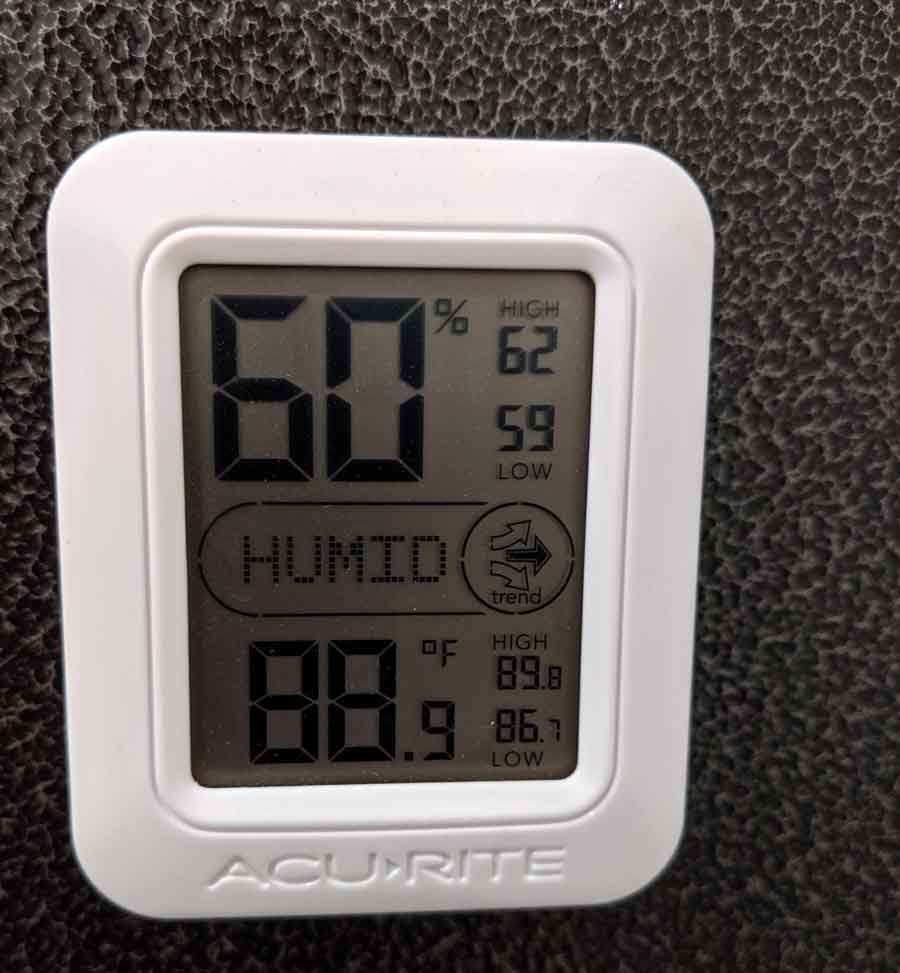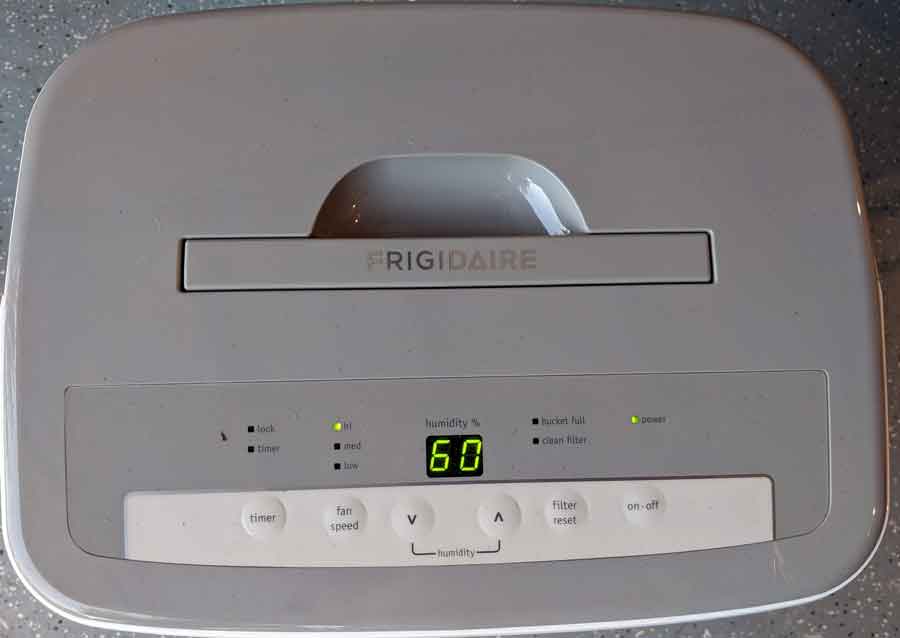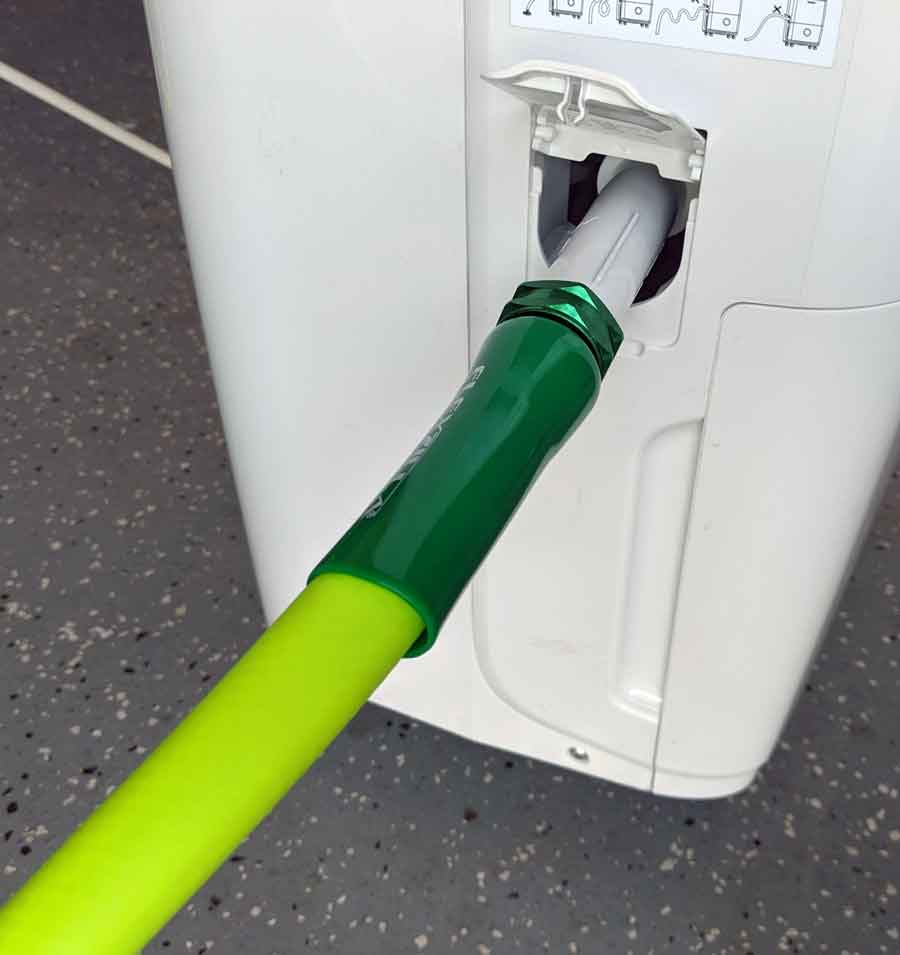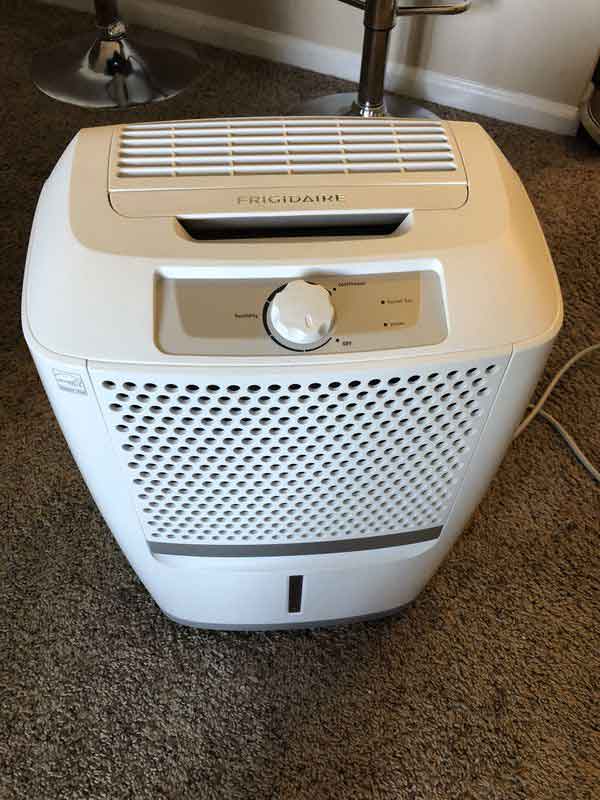I’ll bet you’re in one of two camps right now:
- Your garage freezes in the winter, and you need to heat it up or…
- You’re like me, and you need to lower the humidity level so you don’t sweat as soon as you get out of your car.
If you’re REALLY unlucky, you live somewhere where you need to do both.
I’m sorry. That really sucks.
But even if you don’t live in the hot and humid South, you need to control the humidity levels in your garage. High humidity is bad for your tools, car, and any electronics or paper items in your garage.
An air-conditioned garage would solve that problem, but they’re expensive.
But you CAN do something about the humidity in your garage without needing an air conditioner. The solution is adding a garage dehumidifier into the mix.
That’s what we’ll talk about here.
Frigidaire, White 22-Pint Dehumidifier – FFAD2233W1 |
Govee Temperature Humidity Monitor 2-Pack with App Alert |
Frigidaire, White 35-Pint Dehumidifier (FFAD3533W1) |
|
Primary Rating:
4.7
|
Primary Rating:
4.1
|
Primary Rating:
4.7
|
Table of Contents
When Do You Need To Use A Garage Dehumidifier?
To answer that, I want to get a little more scientific than “wow…it feels humid today.”
To do that, we’re going to need a device called a hygrometer.
A hygrometer is a device that measures the amount of water vapor in the air – more commonly called relative humidity.
If you don’t have a thermometer\hygrometer combo device, I recommend picking one up. You need to look at both temperature and relative humidity together.

Hygrometers are around $15 on Amazon (link here), and there are literally over a hundred different ones to choose from.
Please don’t go crazy and buy an expensive hygrometer unless you like one of its features. Any cheap digital one will do.
If the relative humidity in your garage reads higher than 50%, it is time to consider buying a garage dehumidifier.
- Allows you to remotely monitor temperature and humidity on your phone within a range of 80m/262ft.
- Receive notifications once the data goes beyond your preset range.
Will A Dehumidifier Help Cool A Garage?
Without getting too much into the science (go here if you want that), higher humidity will make our bodies feel hotter than the actual temperature because our bodies can’t sweat and cool off.
In other words, a garage dehumidifier doesn’t actively reduce the temperature. Still, it may help you feel cooler.

A high amount of moisture (humidity) in the air prevents sweat on the skin from evaporating.
That means a humid day will “feel hotter” to us than a less muggy day with the same temperature.
People in Arizona will often shrug off a 110ºF day by saying, “it’s a dry heat,” for the same reason.
Reducing the relative humidity level can make the air temperature feel five to ten degrees cooler than it actually is.
When you’re working in your garage in the middle of the day in mid-August, ten degrees cooler can make all the difference.
That said, bear in mind that a dehumidifier isn’t designed to cool your garage. If you’ve added a dehumidifier and still find it too hot, check out my article on garage cooling ideas and see which wall-mounted oscillating fan I bought to really cool things down.
How to Choose The Right Size Dehumidifier For Your Garage
The size of a dehumidifier is determined by how much water it can pull from the air in a twenty-four-hour period. You’ll commonly see them listed in pints (30 pints, 50 pints, 70 pints, etc.).
To determine what size is best for your garage, you must first answer two questions.
Don’t worry…they’re easy questions, and I’ll help you through each.
First: How big is your garage?
The first thing you need to do is to measure your garage’s square footage. Just grab your trusty tape measure, determine the length and width of the room and multiply those two numbers together.

For example, my garage is 20′ in length and 23′ wide (rounding up). That gives me 460 square feet of space in my two-car garage.
Second: How much excess moisture do you have in your garage?
Now that we know how big your garage is, we need to know how much moisture you need to pull out of the air.
This is subjective, but here are some guidelines to help you out.
EnergyStar.gov breaks down how much moisture is in your room like this:
- Moderately Damp: The room feels damp and has a musty odor only in humid weather.
- Very Damp: The room always feels damp and has a musty odor. Damp spots show on walls and floor. Bare concrete floors appear to “sweat.”
- Wet: The room feels and smells wet. Walls or floor sweat or seepage is present.
- Extremely Wet: Wet floor, or other high load conditions like keeping your washer & dryer in your garage.
Unless your garage has leaks, mold, or other moisture issues, you’re probably in the “Moderately Damp” category.
If you DO have leaks or damp spots on the wall, then I highly recommend you fix those first.
Third: Use this chart to tell the smallest dehumidifier you need
This gives us two critical pieces of information about your garage. We know the moisture level you need to remove and the size of the room overall.
Now, what do we do?
That article on EnergyStar.gov I referenced earlier also included a chart with recommended dehumidifier sizes that I’ve reproduced below.
This chart is broken down into how many pints of excess moisture the dehumidifier would need to pull out of your garage in 24 hours based on the moisture level of your garage.
The number in the box represents the smallest garage dehumidifier that you need.
| Moisture Level | 500 sq. ft | 1,000 sq. ft | 1,500 sq. ft | 2,000 sq. ft | 2,500 sq. ft. |
| Moderately Damp | 10 pt. | 14 pt. | 18 pt. | 22 pt. | 26 pt. |
| Very Damp | 12 pt. | 17 pt. | 22 pt. | 27 pt. | 32 pt. |
| Wet | 14 pt. | 20 pt. | 26 pt. | 32 pt. | 38 pt. |
| Extremely Wet | 16 pt. | 23 pt. | 30 pt. | 37 pt. | 44 pt. |
These recommendations are for your home and aren’t specific to your garage. Your garage isn’t usually insulated, so it’s a more hostile environment.
When in doubt, go with the dehumidifier that covers a slightly larger square footage or moisture category.
I’ll bet you need a smaller dehumidifier than you thought.
I bought my garage dehumidifier without putting a whole lot of thought into it. I over-bought for the size of my garage and spent more money than I needed to.
Don’t Overbuy (Like I Did)
What would a buyer’s guide be without an example of what not to do?
So let me continue with my example,
My 460 sq. ft garage feels like it’s in the “Moderately Damp” category. There aren’t any obvious water leaks or damp spots on the floor, but it does feel pretty hot and humid.
Based on the recommendations above, I could get away with a 10-pint dehumidifier for my garage.
The smallest dehumidifier commonly manufactured is 30 pints. That should be more than enough to handle my size garage, even in “extremely wet” conditions, which, if you remember from above, covers things like drying laundry.
What I actually bought was a 50-pint dehumidifier, which was overkill.
As I said before, I bought my garage dehumidifier before I saw the recommendations from EnergyStar, so I bought into the manufacturer’s recommendations.
The trouble is that they give guidelines for the absolute worst-case scenario rather than what the average consumer needs.
Consumer Reports has repeatedly found that manufacturers are pretty accurate with their metrics. In other words, they consistently pull as much excess moisture out of the air as they advertise (source).
The bottom line is a 30-pint dehumidifier is more than enough for most garages (less than 1,000 sq. ft.) – even for very wet conditions.
In fact, the only time you really need a heavy-duty garage dehumidifier is if you already have a mold and mildew problem or if you have a lot of moisture in the garage from aquariums or a garden.
The Best Garage Dehumidifier (An Owner’s Humble Opinion)
I picked up the Frigidaire 50-pint FFAD5033R1 dehumidifier in June 2018. Besides being one size too big for my garage, I couldn’t be happier with it.
As much as I like my 50-pint garage dehumidifier, I recommend the 30-pint version instead. For the majority of homeowners, the Frigidaire FFAD3033R1 is more than enough.
You can find it on Amazon for well under $200.
At the end of the day, a dehumidifier is an appliance. You won’t fall in love with it, but you want to get one with some great features and reliability.
My 50-pint Frigidaire works overtime in the Florida summers (which last almost all year) and has never given me trouble. It’s been extremely reliable long-term, and it’s a workhorse.
I’m confident that it will keep working well for years to come.
What I like
Digital controls: Frigidaire calls it their Ready-Select controls, but really it’s just a digital readout and control panel.
It’s got all the controls you expect, like fan speed, timer controls, and even warning lights for when you need to replace your filter and when you need to change the water bucket.
You can set the humidity to the desired level, and this garage dehumidifier will work to get it down to that point and then shut itself off.
This isn’t a radical, new feature. In fact, dehumidifiers have had something like it for years. But I like when it’s implemented well and simple to use like it is here.

Energy Efficiency: Like air conditioners, garage dehumidifiers use a lot of energy. So getting one that’s as easy on your electric bill as possible is essential.
If you look at the three Frigidaire dehumidifiers, power usage varies wildly between the three models. The 70-pint model uses a whopping 740 watts at full power. The 50-pint FFAD5033R1 that I bought still uses 530 watts at full strength, which is above the average for dehumidifiers in its class.
Compare that to the 30-pint FFAD3033R1, which uses only 320 watts – about 100 watts less at full power than the older FAD301NWD that it replaced. I’ll go into more of the differences in a separate heading below.
It’s super quiet: My parents had a dehumidifier when I was growing up, and I distinctly remember it sounding like a jet engine. You couldn’t watch TV with it on because you couldn’t hear anything.
So I was really pleasantly surprised when this one was about as quiet as a refrigerator. You can have it running while working in your garage and still listen to music in the background.
Side drain hose outlet: Depending on your garage layout, this may be something you like.

I like that the hose outlet is on the side of the unit and not on the back. I don’t have a drain in my garage floor, so I have to run a standard garden hose out to my garage door.
Manufacturers recommend using a hose less than six feet in length, giving you only a few options for where to place your dehumidifier in your garage.
The side hose outlet lets me still see the digital control panel without moving the unit while simultaneously keeping the hose close enough to the door so it drips directly outside.
It’s not perfect, but it offers a “set it and forget it” environment.
What I don’t
If you’ve been reading this site for a while, you know I’m a bit of a geek. I love smart devices that can be programmed or use voice commands to turn off and on.
The R-model Frigidaire dehumidifiers let you program for a specific humidity level. Still, I like using my Google Home to remotely turn on and off my appliances.
It’s a niche use case, I know.
I use a two-outlet smart switch that controls my
This means that if your power is cut or you use a switched outlet or power strip, as I do, the dehumidifier won’t automatically resume.
It’s not the end of the world and certainly not a deal breaker. Still, it’s a helpful feature to have in a garage dehumidifier.
FFAD3033R1 vs FAD301NWD
Frigidaire makes two models of 30-pint dehumidifiers, so it’s worth reviewing the differences.
The FAD301NWD (pictured below) came out in 2013 and was replaced by the FFAD3033R1. Frigidaire still manufactures both because there are a few differences.

The obvious difference is that the older FAD301NWD has a simple dial control, not the digital readout of the newer model.
As I mentioned earlier, I love setting my dehumidifier for a specific humidity level and having it figure things out on its own.
Under the hood, the electric motor in the newer FFAD3033R1 is rated to do the same job with less energy usage (source), which is really important. Dehumidifiers are not energy efficient, so I appreciate anything that will save money on my monthly electric bill.
From a consumer angle, the two models are only separated by about $15 in cost, so it’s worth going for the newer, more efficient FFAD3033R1 if possible.
This dehumidifier removes up to 22 pints of water per day, drying the air quickly and efficiently. Rolling casters and integrated side handles make it easy and convenient to set up and store.
Wrapping It Up: Why You Might Not Need A Garage Dehumidifier
A dehumidifier can make a significant impact in making your garage more comfortable. Garage dehumidifiers can also help reduce odor in your garage.
But there are cases where buying a garage dehumidifier is just not cost-effective.
For example, suppose you’re constantly opening and closing your garage door. In that case, the air outside will raise humidity levels so quickly that your dehumidifier won’t be able to keep up.
Opening your garage door for a few minutes can take hours to get the humidity level back under control.
Similarly, garage dehumidifiers won’t work well in the winter if you don’t have a heated garage. Most dehumidifiers won’t work effectively in cold temperatures because the coils will freeze.
Manufacturers recommend that you don’t use a dehumidifier when the temperature is lower than 60ºF. If you have a cooler garage and still need a dehumidifier, be sure you’re buying one specifically designed for lower temperatures.





